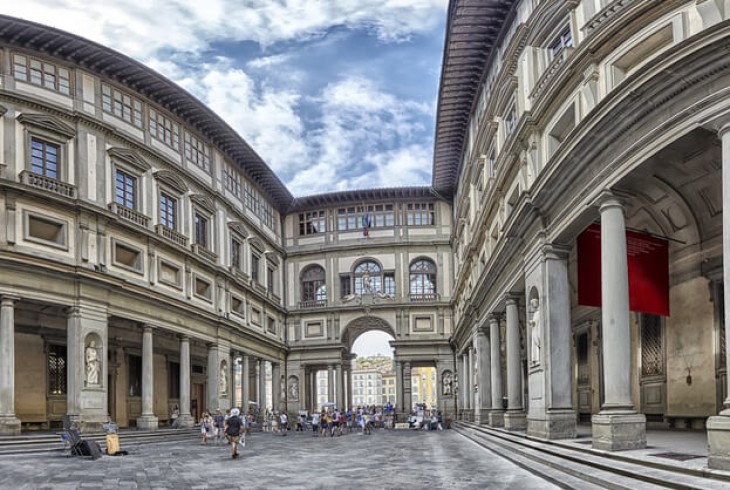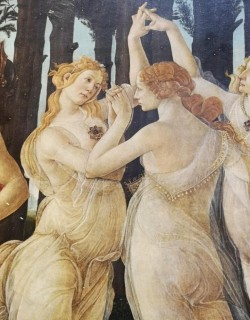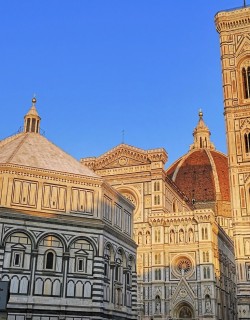8 Sources of Wonder at the Uffizi Gallery
The Galleria Uffizi is truly one of the world’s great museums, and no wonder; it was here under Florentine patronage that one of the world’s great outpourings of creativity — the Italian Renaissance — had its heart. Its sprawling galleries are filled with some of the most iconic masterpieces of art history, and as you wander the halls the greatest artists of the era jostle for attention.
Of course there’s plenty of jostling between visitors too (over 3 million annually), and the crowds have become almost as famous as the canvases. Nevertheless, there are still plenty of opportunities for wonder, and some of the Uffizi’s artworks can capture your attention so completely that everything else melts away. Every visit to the Uffizi Gallery is filled with moments of inspiration, and the following eight sights will elevate your spirit as only art can.
1. The Grandeur of Giotto
The painter Giotto di Bondone is considered one of the seminal figures who sparked the Renaissance; his memorial in the Duomo declares that he resurrected Art itself. With its gold background and static composition, his massive Madonna in the Uffizi still has one foot in the Middle Ages. Yet in its technique and artistry it is embarking on an entirely new endeavor: Giotto’s figures have substance and exist in three dimensions. The artist has achieved here a new mode of depiction and a control of space that would inspire many imitators and go on to define the course of Western Art.
2. The Thrill of a Renaissance Battle
Armor clangs and horses scream in Paolo Uccello’s daring depiction of the Battle of San Romano. Capturing intense combat between Florence and neighboring Siena, the scene is full of the chaos of war: armed knights ready their lances, their steeds buck and rear, and the ground is littered with broken weapons and bodies. Uccello is rightly admired for the frenetic energy he instils into his figures, as well as his ability to show horses from so many different angles in this whirlwind of flesh and metal.
3. The Allure of Botticelli’s Venus
No other painting of the Florentine Renaissance is more iconic than The Birth of Venus by Sandro Botticelli. Taking as his subject a scene not from history or the Bible but from pagan mythology, the artist shows the Goddess of Love rising out of the sea. Choosing this subject may have given him license to do something no artist had done since antiquity: a large-scale female nude. With this painting, Botticelli initiated an obsession that would continue to captivate artists (and viewers) for the next five hundred years.
4. The Subtlety of an Unfinished Leonardo
The mysterious qualities of Leonardo da Vinci’s paintings––their veiled atmosphere and subtle coloration––are the products of a complex and laborious working method. That technique, often obscure, is on full display in a recently restored canvas in the Uffizi. In 1481, Leonardo left Florence, abandoning half-finished a large painting of The Adoration of the Magi. Over the years, misguided efforts to finish or “improve” it had damaged the work, but thanks to the new restorations––completed only in 2017––the painting is refreshed and vivid, allowing us to witness the genius at work.
5. The Force of Michelangelo
Given that he is so well known for his work on the ceiling of the Sistine Chapel, it is surprising to learn that Michelangelo didn’t really think of himself as a painter. Indeed, there exist only three-panel paintings by his hand, and only one was ever finished. The Uffizi’s Doni Tondo was completed not long before he started work on the pope’s ceiling, and it prefigures that project in many important ways. In its depiction of the Holy Family, the Tondo is striking for its use of bright colors and the atypical muscularity of its figures––all features that Michelangelo would later use in the Vatican.
6. The Delicate Energy of Early Raphael
After moving to Rome and seeing what Michelangelo was creating on the Sistine Ceiling, Raphael became inspired to instill his paintings with more action and intensity. His early paintings in the Uffizi, however, are still indebted to the tranquility of his teacher Perugino and are filled with more grace than movement. Their character, however, reveals how early the student had outgrown the master: the many portraits on display capture not only the features of the sitter but also something of their character, and Raphael’s Madonna of the Goldfinch manages to sustain both delicacy and liveliness.
7. The Drama of Caravaggio
With his bold composition and dramatic expressions, Caravaggio developed a radically new kind of painting. The artist’s Medusa is a triumph of observation and invention, capturing the frozen horror of the Gorgon’s expression much like she turned her victims into stone. Even more virtuosic is the fact that Caravaggio painted onto the curved surface of a shield; this is surely an illusion to the myth, in which the hero Perseus kills Medusa with the help of a mirrored shield. The horror Caravaggio instills in her face is thus derived from the knowledge of both her imminent death and her true, monstrous nature.
8. The Bold Feminism of Gentileschi
Artemisia Gentileschi was one of the most astounding followers of Caravaggio: astounding for her talents, but also for her strength and perseverance at a time when female artists were not easily accepted by society. Her skill as a painter rivals that of any man, and at the Uffizi her Judith and Holofernes does exactly that.
In its style, subject and composition, the canvas demands comparison with a similar one by Caravaggio in Rome; unlike that artist’s hesitant maiden, however, Gentileschi’s Judith is full of strength and determination. Indeed, scholars have proposed that it is a self-portrait, and the features of Holofernes are those of a man once convicted of raping the artist. The biblical account is thus transformed into a startlingly contemporary and personal declaration of female power.
Tips for visiting the Uffizi Gallery
Plan on visiting around lunch-time or later in the day when crowds are smaller. With a bit of planning you can avoid the notorious lines; either buy your tickets in advance or book a Skip-the-Lines Florence Tour. Inside, try to find the calm “eye of the storm” between two massive tour groups.
Through Eternity offers group and private tours of the Uffizi Gallery, as well as a private art lovers’ tour that also includes Michelangelo’s David.




